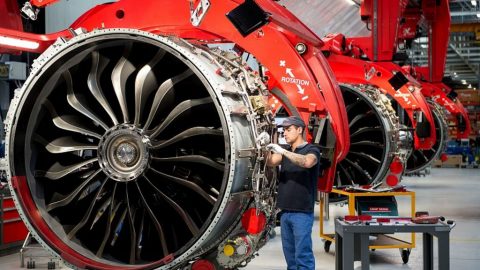-
 TPM Case Study: How Tecate Gets TPM Right (Part 2)
Today, plant maintenance organizations are comprised of three intertwined “chain links”. Maintenance engineering personnel analyze, develop and revamp the asset care plans for plant equipment. They lead root cause and problem-solving events that get to the heart of equipment problems, and carry the findings into future reliability-enhancement strategies. As Sanchez says,...
TPM Case Study: How Tecate Gets TPM Right (Part 2)
Today, plant maintenance organizations are comprised of three intertwined “chain links”. Maintenance engineering personnel analyze, develop and revamp the asset care plans for plant equipment. They lead root cause and problem-solving events that get to the heart of equipment problems, and carry the findings into future reliability-enhancement strategies. As Sanchez says,...
-
 Aerospace supplier reduces production process from 90 hours to 18
A Lancashire-based precision engineering company, which supplies to the LEAP aircraft engine, has reduced production time drastically by installing Industry 4.0 technologies. T&R Precision was incorporated over 20 years ago by father and son engineers Ray and Tim Maddison and has grown to be a key part of the supply chain...
Aerospace supplier reduces production process from 90 hours to 18
A Lancashire-based precision engineering company, which supplies to the LEAP aircraft engine, has reduced production time drastically by installing Industry 4.0 technologies. T&R Precision was incorporated over 20 years ago by father and son engineers Ray and Tim Maddison and has grown to be a key part of the supply chain...
-
 TPM Case Study: How Tecate Gets TPM Right (Part 1)
Total productive maintenance (TPM) does not have a great reputation in American industry these days. A study conducted in 2006 by The Manufacturing Research Center showed that only 38 percent of U.S. manufacturers surveyed were currently implementing TPM. Of those implementing TPM, 37 percent said they weren’t making as much progress...
TPM Case Study: How Tecate Gets TPM Right (Part 1)
Total productive maintenance (TPM) does not have a great reputation in American industry these days. A study conducted in 2006 by The Manufacturing Research Center showed that only 38 percent of U.S. manufacturers surveyed were currently implementing TPM. Of those implementing TPM, 37 percent said they weren’t making as much progress...
-
 Factors influencing your factory choice of CNC equipment (Part 3)
The continuous development of technology has brought many breakthrough achievements for many manufacturing industries in the world, and the field of precision machining is no exception. The achievements in digitization and automation are now having a strong impact on the production efficiency of enterprises that are applying new generation CNC equipment....
Factors influencing your factory choice of CNC equipment (Part 3)
The continuous development of technology has brought many breakthrough achievements for many manufacturing industries in the world, and the field of precision machining is no exception. The achievements in digitization and automation are now having a strong impact on the production efficiency of enterprises that are applying new generation CNC equipment....
-
 Types of analysis in the analytical phase of the DMAIC method (Part 2) ...
In this section, we will continue to explore the remaining 2 steps in the analysis phase of DMAIC, namely Graphic Analysis and Statistical Analysis. Graphic analysis: The next step involves using the tools and techniques associated with the Analysis phase. Most of these tools end up with a graphical map. The...
Types of analysis in the analytical phase of the DMAIC method (Part 2) ...
In this section, we will continue to explore the remaining 2 steps in the analysis phase of DMAIC, namely Graphic Analysis and Statistical Analysis. Graphic analysis: The next step involves using the tools and techniques associated with the Analysis phase. Most of these tools end up with a graphical map. The...
-
 Types of analysis in the analytical phase of the DMAIC method (Part 1) ...
The Six Sigma DMAIC method (Identification, Measurement, Analysis, Improvement, Control) can be defined as a roadmap for problem solving and process improvement. The problem phase identifies the problem, the measurement phase collects data and uses it to measure performance. The third phase, that is, the analysis phase, focuses on identifying, statistical...
Types of analysis in the analytical phase of the DMAIC method (Part 1) ...
The Six Sigma DMAIC method (Identification, Measurement, Analysis, Improvement, Control) can be defined as a roadmap for problem solving and process improvement. The problem phase identifies the problem, the measurement phase collects data and uses it to measure performance. The third phase, that is, the analysis phase, focuses on identifying, statistical...
-
 Why can input testing (FAI) save products from quality problems? (Part 3)
In many cases, the buyer verification of the “first test pieces” is actually not an entrance test (FAI). Many other Asian manufacturers prepare them in a model room, rather than in cutting and sewing workshops. The technician will not only run a functional test, but also perform a visual examination on...
Why can input testing (FAI) save products from quality problems? (Part 3)
In many cases, the buyer verification of the “first test pieces” is actually not an entrance test (FAI). Many other Asian manufacturers prepare them in a model room, rather than in cutting and sewing workshops. The technician will not only run a functional test, but also perform a visual examination on...
-
 Why can input testing (FAI) save products from quality problems? (Part 2)
That is convenient, but many manufacturers often ignore FAI. The reason is simple: To save a little time. This is an indication of a tendency to be overly optimistic and not predict the potential problems that may occur. If they look back on their past quality issues (and the money they...
Why can input testing (FAI) save products from quality problems? (Part 2)
That is convenient, but many manufacturers often ignore FAI. The reason is simple: To save a little time. This is an indication of a tendency to be overly optimistic and not predict the potential problems that may occur. If they look back on their past quality issues (and the money they...
-
 Solutions to minimize defective products and errors in industrial production (Part 2)
Besides direct impact methods and sources of error (people, equipment), there are many other indirect solutions that can significantly reduce defective products and errors during the manufacturing process. Here are some examples: Improve management and communication skills Accessories often appear when the ability to communicate between the stages of the production...
Solutions to minimize defective products and errors in industrial production (Part 2)
Besides direct impact methods and sources of error (people, equipment), there are many other indirect solutions that can significantly reduce defective products and errors during the manufacturing process. Here are some examples: Improve management and communication skills Accessories often appear when the ability to communicate between the stages of the production...
-
 Solutions to minimize defective products and errors in industrial production (Part 1)
Creating faulty and defective products is one of the inevitable in industrial production, and to handle them is also very costly. Careful manufacturing planning can minimize the material loss and the effort required to handle defective products. Firstly, “by-products” are parts of the excess material in the production process. It is...
Solutions to minimize defective products and errors in industrial production (Part 1)
Creating faulty and defective products is one of the inevitable in industrial production, and to handle them is also very costly. Careful manufacturing planning can minimize the material loss and the effort required to handle defective products. Firstly, “by-products” are parts of the excess material in the production process. It is...
Scroll
 TPM Case Study: How Tecate Gets TPM Right (Part 2)
Today, plant maintenance organizations are comprised of three intertwined “chain links”. Maintenance engineering personnel analyze, develop and revamp the asset care plans for plant equipment. They lead root cause and problem-solving events that get to the heart of equipment problems, and carry the findings into future reliability-enhancement strategies. As Sanchez says,...
TPM Case Study: How Tecate Gets TPM Right (Part 2)
Today, plant maintenance organizations are comprised of three intertwined “chain links”. Maintenance engineering personnel analyze, develop and revamp the asset care plans for plant equipment. They lead root cause and problem-solving events that get to the heart of equipment problems, and carry the findings into future reliability-enhancement strategies. As Sanchez says,...
 Aerospace supplier reduces production process from 90 hours to 18
A Lancashire-based precision engineering company, which supplies to the LEAP aircraft engine, has reduced production time drastically by installing Industry 4.0 technologies. T&R Precision was incorporated over 20 years ago by father and son engineers Ray and Tim Maddison and has grown to be a key part of the supply chain...
Aerospace supplier reduces production process from 90 hours to 18
A Lancashire-based precision engineering company, which supplies to the LEAP aircraft engine, has reduced production time drastically by installing Industry 4.0 technologies. T&R Precision was incorporated over 20 years ago by father and son engineers Ray and Tim Maddison and has grown to be a key part of the supply chain...
 TPM Case Study: How Tecate Gets TPM Right (Part 1)
Total productive maintenance (TPM) does not have a great reputation in American industry these days. A study conducted in 2006 by The Manufacturing Research Center showed that only 38 percent of U.S. manufacturers surveyed were currently implementing TPM. Of those implementing TPM, 37 percent said they weren’t making as much progress...
TPM Case Study: How Tecate Gets TPM Right (Part 1)
Total productive maintenance (TPM) does not have a great reputation in American industry these days. A study conducted in 2006 by The Manufacturing Research Center showed that only 38 percent of U.S. manufacturers surveyed were currently implementing TPM. Of those implementing TPM, 37 percent said they weren’t making as much progress...
 Factors influencing your factory choice of CNC equipment (Part 3)
The continuous development of technology has brought many breakthrough achievements for many manufacturing industries in the world, and the field of precision machining is no exception. The achievements in digitization and automation are now having a strong impact on the production efficiency of enterprises that are applying new generation CNC equipment....
Factors influencing your factory choice of CNC equipment (Part 3)
The continuous development of technology has brought many breakthrough achievements for many manufacturing industries in the world, and the field of precision machining is no exception. The achievements in digitization and automation are now having a strong impact on the production efficiency of enterprises that are applying new generation CNC equipment....
 Types of analysis in the analytical phase of the DMAIC method (Part 2) ...
In this section, we will continue to explore the remaining 2 steps in the analysis phase of DMAIC, namely Graphic Analysis and Statistical Analysis. Graphic analysis: The next step involves using the tools and techniques associated with the Analysis phase. Most of these tools end up with a graphical map. The...
Types of analysis in the analytical phase of the DMAIC method (Part 2) ...
In this section, we will continue to explore the remaining 2 steps in the analysis phase of DMAIC, namely Graphic Analysis and Statistical Analysis. Graphic analysis: The next step involves using the tools and techniques associated with the Analysis phase. Most of these tools end up with a graphical map. The...
 Types of analysis in the analytical phase of the DMAIC method (Part 1) ...
The Six Sigma DMAIC method (Identification, Measurement, Analysis, Improvement, Control) can be defined as a roadmap for problem solving and process improvement. The problem phase identifies the problem, the measurement phase collects data and uses it to measure performance. The third phase, that is, the analysis phase, focuses on identifying, statistical...
Types of analysis in the analytical phase of the DMAIC method (Part 1) ...
The Six Sigma DMAIC method (Identification, Measurement, Analysis, Improvement, Control) can be defined as a roadmap for problem solving and process improvement. The problem phase identifies the problem, the measurement phase collects data and uses it to measure performance. The third phase, that is, the analysis phase, focuses on identifying, statistical...
 Why can input testing (FAI) save products from quality problems? (Part 3)
In many cases, the buyer verification of the “first test pieces” is actually not an entrance test (FAI). Many other Asian manufacturers prepare them in a model room, rather than in cutting and sewing workshops. The technician will not only run a functional test, but also perform a visual examination on...
Why can input testing (FAI) save products from quality problems? (Part 3)
In many cases, the buyer verification of the “first test pieces” is actually not an entrance test (FAI). Many other Asian manufacturers prepare them in a model room, rather than in cutting and sewing workshops. The technician will not only run a functional test, but also perform a visual examination on...
 Why can input testing (FAI) save products from quality problems? (Part 2)
That is convenient, but many manufacturers often ignore FAI. The reason is simple: To save a little time. This is an indication of a tendency to be overly optimistic and not predict the potential problems that may occur. If they look back on their past quality issues (and the money they...
Why can input testing (FAI) save products from quality problems? (Part 2)
That is convenient, but many manufacturers often ignore FAI. The reason is simple: To save a little time. This is an indication of a tendency to be overly optimistic and not predict the potential problems that may occur. If they look back on their past quality issues (and the money they...
 Solutions to minimize defective products and errors in industrial production (Part 2)
Besides direct impact methods and sources of error (people, equipment), there are many other indirect solutions that can significantly reduce defective products and errors during the manufacturing process. Here are some examples: Improve management and communication skills Accessories often appear when the ability to communicate between the stages of the production...
Solutions to minimize defective products and errors in industrial production (Part 2)
Besides direct impact methods and sources of error (people, equipment), there are many other indirect solutions that can significantly reduce defective products and errors during the manufacturing process. Here are some examples: Improve management and communication skills Accessories often appear when the ability to communicate between the stages of the production...
 Solutions to minimize defective products and errors in industrial production (Part 1)
Creating faulty and defective products is one of the inevitable in industrial production, and to handle them is also very costly. Careful manufacturing planning can minimize the material loss and the effort required to handle defective products. Firstly, “by-products” are parts of the excess material in the production process. It is...
Solutions to minimize defective products and errors in industrial production (Part 1)
Creating faulty and defective products is one of the inevitable in industrial production, and to handle them is also very costly. Careful manufacturing planning can minimize the material loss and the effort required to handle defective products. Firstly, “by-products” are parts of the excess material in the production process. It is...